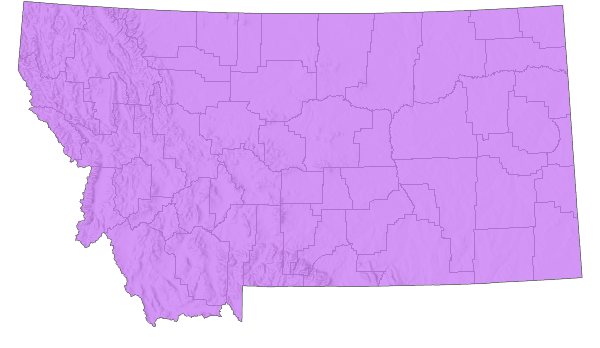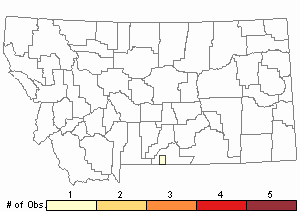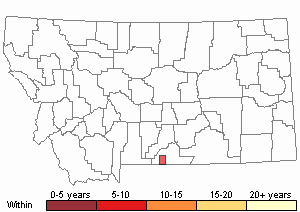View in other NatureServe Network Field Guides
NatureServe
Montana
Utah
Wyoming
Idaho
Wisconsin
British Columbia
South Carolina
Yukon
California
New York
Shasta Blue - Icaricia shasta
Native Species
Global Rank:
G4
State Rank:
S5
Agency Status
USFWS:
USFS:
BLM:
External Links
General Description
[From Ferris and Brown 1981; Scott 1986; Opler and Wright 1999; Glassberg 2001; Pyle 2002] Forewing 1.0-1.3 cm. Lacking tails. Uppersurface of both sexes with forewing cell bar, male dull to dark iridescent blue with black marginal line and brownish submarginal band, female brown with some blue basally, hindwing with row of submarginal black spots capped with orange crescents on inward side. Undersurface gray with black spots, brown blotches, pale wing veins giving mottled appearance; hindwing with a pale orange submarginal band capped with inward-pointing black chevrons and containing metallic blue-green spots, hindwing postmedian spots dark brown to pale gray-brown but not black.
Phenology
One flight; mostly late June through July, mid-July to mid-August at or above treeline (Scott 1986). June to September (Glassberg 2001). Early June to early September (Emmel and Shields 1978). Mid-July to mid-August in Colorado (Scott and Scott 1978), mid-July to late August in Oregon (Pyle 2002; Warren 2005).
Diagnostic Characteristics
Best determined by a combination of uppersurface of male with black marginal line and brownish submarginal band, female brown with some blue basally, hindwing with row of submarginal black spots capped with orange crescents on inward side. Undersurface mottled, hindwing with a pale orange submarginal band capped with inward-pointing black chevrons and containing metallic blue-green spots, hindwing postmedian spots dark brown to pale gray-brown but not black.
Species Range
Montana Range
Range Descriptions

 Native
Native
Range Comments
Oregon, southern Alberta, southern Saskatchewan, south in mountains and intermountain west to central California, southern Nevada, southern Utah, southern Colorado, also to western North Dakota, Black Hills region of South Dakota, western Nebraska (Scott 1986; Opler and Wright 1999; Glassberg 2001), not yet reported from Washington and British Columbia (Guppy and Shepard 2001; Pyle 2002); lower elevation subspecies 1525 m to 3048 m elevation in Colorado, high elevation subspecies above treeline to at least 3962 m elevation (Brown 1957; Scott and Scott 1978; Ferris and Brown 1981), 1554 m to 3505 m elevation in Wyoming (Emmel and Shields 1978), 1920 m to 3719 m elevation in California (Emmel and Shields 1978), 1829 m to 3475 m elevation in Nevada (Emmel and Shields 1978; Austin 1980), 914 m to 2957 m elevation in Oregon (Warren 2005). In Montana, reported from at least 26 counties across the state, rarely west of the continental divide (Kohler 1980; Stanford and Opler 1993; FLMNH Lepidopterists' Society database). Locally common (Glassberg 2001).
Observations in Montana Natural Heritage Program Database
Number of Observations: 1
(Click on the following maps and charts to see full sized version)
Map Help and Descriptions
Relative Density

Recency



 (Observations spanning multiple months or years are excluded from time charts)
(Observations spanning multiple months or years are excluded from time charts)
Migration
Non-migratory.
Habitat
Alpine fellfield, subalpine rocky slopes and ridges, well-drained forest openings, blowouts, sagebrush-steppe, prairie hills (Emmel and Shields 1978; Austin 1980; Scott 1986; Opler and Wright 1999; Glassberg 2001; Pyle 2002). In Greater Yellowstone Ecosystem, associated with xeric montane meadows dominated by sagebrush (Debinski et al. 2013).
Food Habits
Larval food plants include Astragalus (multiple species), Lupinus (multiple species), Oxytropis, and Trifolium (multiple species) (Emmel and Shields 1978; Scott 1986, 1992). Adults feed on flower nectar, including Arnica, Cistanthe, Erigeron, Eriogonum, Haplopappus, Heterotheca, Sedum, and Solidago (Pyle 2002; Scott 2014).
Reproductive Characteristics
Females lay eggs singly on underside of host plant leaves, sometimes on stems, seed pods, on ground litter near base of plant (Emmel and Shields 1978; Scott 1986, 1992). Larvae feed on young leaves and flowers of host plant, pupation occurs in litter near base of host plant and on undersides of rocks, adults eclose (emerge from pupae) in about 14 days. Biennial; hibernate first winter as egg, second winter as nearly mature larvae (Emmel and Shields 1978; Scott 1986, 1992). Post-diapause larvae in natural conditions in California tended by ants (four species of Formica) (Emmel and Shields 1978), also by Formica in captivity (Ballmer and Pratt 1991). Males patrol throughout the day low to the ground (< 10 cm) near host plants in cushion-plant communities on sparsely-vegetated ridges and slopes in search of females (Scott 1975b, 1986).
Stewardship Responsibility
References
- Literature Cited AboveLegend:
 View Online Publication
View Online Publication Austin, G.T. 1980. A new Plebejus (Icaricia) shasta (Edwards) from southern Nevada (Lycaenidae). Journal of the Lepidopterists' Society 34: 20-24.
Austin, G.T. 1980. A new Plebejus (Icaricia) shasta (Edwards) from southern Nevada (Lycaenidae). Journal of the Lepidopterists' Society 34: 20-24. Ballmer, G.R. and G.F. Pratt. 1991. Quantification of ant attendance (myrmecophily) of lycaenid larvae. Journal of Research on the Lepidoptera 30(1-2): 95-112.
Ballmer, G.R. and G.F. Pratt. 1991. Quantification of ant attendance (myrmecophily) of lycaenid larvae. Journal of Research on the Lepidoptera 30(1-2): 95-112. Brown, F.M. 1957. Colorado Butterflies. Proceedings; Numbers Three through Seven. Denver Museum of Natural History, Denver, Co.
Brown, F.M. 1957. Colorado Butterflies. Proceedings; Numbers Three through Seven. Denver Museum of Natural History, Denver, Co. Debinski, D.M., J.C. Caruthers, D. Cook, J. Crowley, and H. Wickham. 2013. Gradient-based habitat affinities predict species vulnerability to drought. Ecology 94(5): 1036-1045.
Debinski, D.M., J.C. Caruthers, D. Cook, J. Crowley, and H. Wickham. 2013. Gradient-based habitat affinities predict species vulnerability to drought. Ecology 94(5): 1036-1045. Emmel, J.F. and O. Shields. 1978. The biology of Plebejus (Icaricia) shasta in the western United States (Lycaenidae). Journal of Research on the Lepidoptera 17: 129-140.
Emmel, J.F. and O. Shields. 1978. The biology of Plebejus (Icaricia) shasta in the western United States (Lycaenidae). Journal of Research on the Lepidoptera 17: 129-140. Ferris, C.D. and F.M. Brown (eds). 1981. Butterflies of the Rocky Mountains. Univ. of Oklahoma Press. Norman. 442 pp.
Ferris, C.D. and F.M. Brown (eds). 1981. Butterflies of the Rocky Mountains. Univ. of Oklahoma Press. Norman. 442 pp. Glassberg, J. 2001. Butterflies through Binoculars: A Field Guide to the Butterflies of Western North America. Oxford University Press.
Glassberg, J. 2001. Butterflies through Binoculars: A Field Guide to the Butterflies of Western North America. Oxford University Press. Guppy, C.S. and J.H. Shepard. 2001. Butterflies of British Columbia: including western Alberta, southern Yukon, the Alaska Panhandle, Washington, northern Oregon, northern Idaho, northwestern Montana. UBC Press (Vancouver, BC) and Royal British Columbia Museum (Victoria, BC). 414 pp.
Guppy, C.S. and J.H. Shepard. 2001. Butterflies of British Columbia: including western Alberta, southern Yukon, the Alaska Panhandle, Washington, northern Oregon, northern Idaho, northwestern Montana. UBC Press (Vancouver, BC) and Royal British Columbia Museum (Victoria, BC). 414 pp. Kohler, S. 1980. Checklist of Montana Butterflies (Rhopalocera). Journal of the Lepidopterists' Society 34(1): 1-19.
Kohler, S. 1980. Checklist of Montana Butterflies (Rhopalocera). Journal of the Lepidopterists' Society 34(1): 1-19. Opler, P.A. and A.B. Wright. 1999. A field guide to western butterflies. Second edition. Peterson Field Guides. Houghton Mifflin Company, Boston, Massachusetts. 540 pp.
Opler, P.A. and A.B. Wright. 1999. A field guide to western butterflies. Second edition. Peterson Field Guides. Houghton Mifflin Company, Boston, Massachusetts. 540 pp. Pyle, R.M. 2002. The butterflies of Cascadia: a field guide to all the species of Washington, Oregon, and surrounding territories. Seattle Audubon Society, Seattle, Washington. 420 pp.
Pyle, R.M. 2002. The butterflies of Cascadia: a field guide to all the species of Washington, Oregon, and surrounding territories. Seattle Audubon Society, Seattle, Washington. 420 pp. Scott, J.A. 1975b. Mate-locating behavior of western North American butterflies. Journal of Research on the Lepidoptera 14:1-40.
Scott, J.A. 1975b. Mate-locating behavior of western North American butterflies. Journal of Research on the Lepidoptera 14:1-40. Scott, J.A. 1986. The butterflies of North America: a natural history and field guide. Stanford University Press, Stanford, California.
Scott, J.A. 1986. The butterflies of North America: a natural history and field guide. Stanford University Press, Stanford, California. Scott, J.A. 1992. Hostplant records for butterflies and skippers (mostly from Colorado) 1959-1992, with new life histories and notes on oviposition, immatures, and ecology. Papilio new series #6. 185 p.
Scott, J.A. 1992. Hostplant records for butterflies and skippers (mostly from Colorado) 1959-1992, with new life histories and notes on oviposition, immatures, and ecology. Papilio new series #6. 185 p. Scott, J.A. 2014. Lepidoptera of North America 13. Flower visitation by Colorado butterflies (40,615 records) with a review of the literature on pollination of Colorado plants and butterfly attraction (Lepidoptera: Hersperioidea and Papilionoidea). Contributions of the C.P. Gillette Museum of Arthopod Diversity. Fort Collins, CO: Colorado State University. 190 p.
Scott, J.A. 2014. Lepidoptera of North America 13. Flower visitation by Colorado butterflies (40,615 records) with a review of the literature on pollination of Colorado plants and butterfly attraction (Lepidoptera: Hersperioidea and Papilionoidea). Contributions of the C.P. Gillette Museum of Arthopod Diversity. Fort Collins, CO: Colorado State University. 190 p. Scott, J.A. and G.R. Scott. 1978. Ecology and distribution of the butterflies of southern central Colorado. Journal of Research on the Lepidoptera 17(2): 73-128.
Scott, J.A. and G.R. Scott. 1978. Ecology and distribution of the butterflies of southern central Colorado. Journal of Research on the Lepidoptera 17(2): 73-128. Stanford, R.E. and P.A. Opler. 1993. Atlas of western USA butterflies: including adjacent parts of Canada and Mexico. Unpubl. Report. Denver and Fort Collins, Colorado 275 pp.
Stanford, R.E. and P.A. Opler. 1993. Atlas of western USA butterflies: including adjacent parts of Canada and Mexico. Unpubl. Report. Denver and Fort Collins, Colorado 275 pp. Warren, A.D. 2005. Lepidoptera of North America 6: Butterflies of Oregon, their taxonomy, distribution, and biology. Contributions of the C. P. Gillette Museum of Arthropod Diversity, Colorado State University. Fort Collins, Colorado. 406 pp.
Warren, A.D. 2005. Lepidoptera of North America 6: Butterflies of Oregon, their taxonomy, distribution, and biology. Contributions of the C. P. Gillette Museum of Arthropod Diversity, Colorado State University. Fort Collins, Colorado. 406 pp.
- Additional ReferencesLegend:
 View Online Publication
View Online Publication
Do you know of a citation we're missing? Allen, T.J., J.P. Brock, and J. Glassberg. 2005. Caterpillars in the field and garden: a field guide to the butterfly caterpillars of North America. Oxford University Press.
Allen, T.J., J.P. Brock, and J. Glassberg. 2005. Caterpillars in the field and garden: a field guide to the butterfly caterpillars of North America. Oxford University Press. Brock, J.P. and K. Kaufman. 2003. Kaufman Field Guide to Butterflies of North America. Houghton Mifflin Company, New York, NY 284 pp.
Brock, J.P. and K. Kaufman. 2003. Kaufman Field Guide to Butterflies of North America. Houghton Mifflin Company, New York, NY 284 pp. Caruthers, J.C., and D. Debinski. 2006. Montane meadow butterfly species distributions in the Greater Yellowstone Ecosystem. University of Wyoming National Park Service Research Center Annual Report, 2006. Vol. 30, Art. 14. 85-96.
Caruthers, J.C., and D. Debinski. 2006. Montane meadow butterfly species distributions in the Greater Yellowstone Ecosystem. University of Wyoming National Park Service Research Center Annual Report, 2006. Vol. 30, Art. 14. 85-96. Debinski, D.M. and J.A. Pritchard. 2002. A field guide to the butterflies of the Greater Yellowstone Ecosystem. Lanham, MD: Roberts Rinehart Publishers. 107 p.
Debinski, D.M. and J.A. Pritchard. 2002. A field guide to the butterflies of the Greater Yellowstone Ecosystem. Lanham, MD: Roberts Rinehart Publishers. 107 p.
- Web Search Engines for Articles on "Shasta Blue"
- Additional Sources of Information Related to "Insects"





